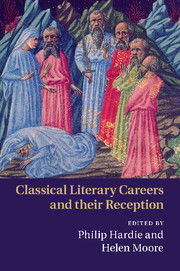Book contents
- Frontmatter
- Contents
- List of contributors
- Preface
- Note on the text
- Introduction: Literary careers – Classical models and their receptions
- 1 Some Virgilian unities
- 2 There and back again: Horace's poetic career
- 3 The Ovidian career model: Ovid, Gallus, Apuleius, Boccaccio
- 4 An elegist's career: from Cynthia to Cornelia
- 5 Persona and satiric career in Juvenal
- 6 The indistinct literary careers of Cicero and Pliny the Younger
- 7 Re-inventing Virgil's Wheel: the poet and his work from Dante to Petrarch
- 8 Did Shakespeare have a literary career?
- 9 New spins on old rotas: Virgil, Ovid, Milton
- 10 Bookburning and the poetic deathbed: the legacy of Virgil
- 11 Literary afterlives: metempsychosis from Ennius to Jorge Luis Borges
- 12 ‘Mirrored doubles’: Andrew Marvell, the remaking of poetry and the poet's career
- 13 Dryden and the complete career
- 14 Goethe's elegiac sabbatical
- 15 Wordsworth's career prospects: ‘peculiar language’ and public epigraphs
- Epilogue: Inventing a life – a personal view of literary careers
- List of works cited
- Index
7 - Re-inventing Virgil's Wheel: the poet and his work from Dante to Petrarch
Published online by Cambridge University Press: 10 November 2010
- Frontmatter
- Contents
- List of contributors
- Preface
- Note on the text
- Introduction: Literary careers – Classical models and their receptions
- 1 Some Virgilian unities
- 2 There and back again: Horace's poetic career
- 3 The Ovidian career model: Ovid, Gallus, Apuleius, Boccaccio
- 4 An elegist's career: from Cynthia to Cornelia
- 5 Persona and satiric career in Juvenal
- 6 The indistinct literary careers of Cicero and Pliny the Younger
- 7 Re-inventing Virgil's Wheel: the poet and his work from Dante to Petrarch
- 8 Did Shakespeare have a literary career?
- 9 New spins on old rotas: Virgil, Ovid, Milton
- 10 Bookburning and the poetic deathbed: the legacy of Virgil
- 11 Literary afterlives: metempsychosis from Ennius to Jorge Luis Borges
- 12 ‘Mirrored doubles’: Andrew Marvell, the remaking of poetry and the poet's career
- 13 Dryden and the complete career
- 14 Goethe's elegiac sabbatical
- 15 Wordsworth's career prospects: ‘peculiar language’ and public epigraphs
- Epilogue: Inventing a life – a personal view of literary careers
- List of works cited
- Index
Summary
The Italian word for ‘career’, carriera, had become associated with a working life or employment from the mid-1600s, long before its English equivalent acquired the same sense in the early nineteenth century. In fact the first attested use of carriera in this way was in association with the profession of literature. In the preface to his Trattato dell'arte e dello stile del dialogo (1662), the historian and poet Pietro Sforza Pallavicino expressed his thanks to the Bishop of Fermo for encouraging his ‘childhood in the career of letters’ (la mia puerizia nella carriera delle lettere).
Carriera, like the Latin via carraria from which it derives, originally denoted a ‘carriage road’ or track for a wheeled vehicle (carrus). The meaning turns out to have a felicitous bearing on the idea of the literary career which is unlikely to be coincidence: in the middle ages, the most influential literary career of all was visualized as a wheel – the rota Vergilii or rota Vergiliana (‘the Wheel of Virgil’.) An arrangement of the poet's works and their respective themes and styles in a circular diagram seems to have developed from the use of rota as synecdoche for the Classical image of the Muses' chariot, an image mediated by the schoolmasters of late antiquity. And when Virgil conceives his poetic cursus as a military triumph at the opening of Georgics Book 3, he envisages himself as a victor, crowned with palms, who will set a hundred chariots in motion.
- Type
- Chapter
- Information
- Classical Literary Careers and their Reception , pp. 138 - 159Publisher: Cambridge University PressPrint publication year: 2010
- 2
- Cited by

